This is an explainer of healthcare SEO for local clinics, to allow clinic owners to understand the factors involved and prioritise their SEO activities.
Local Search
Google has two modes – local and (inter)national.
When you enter certain terms in your Google search such as “near me” or a town name, Google automatically goes into local mode. It returns a map with local businesses, like this:
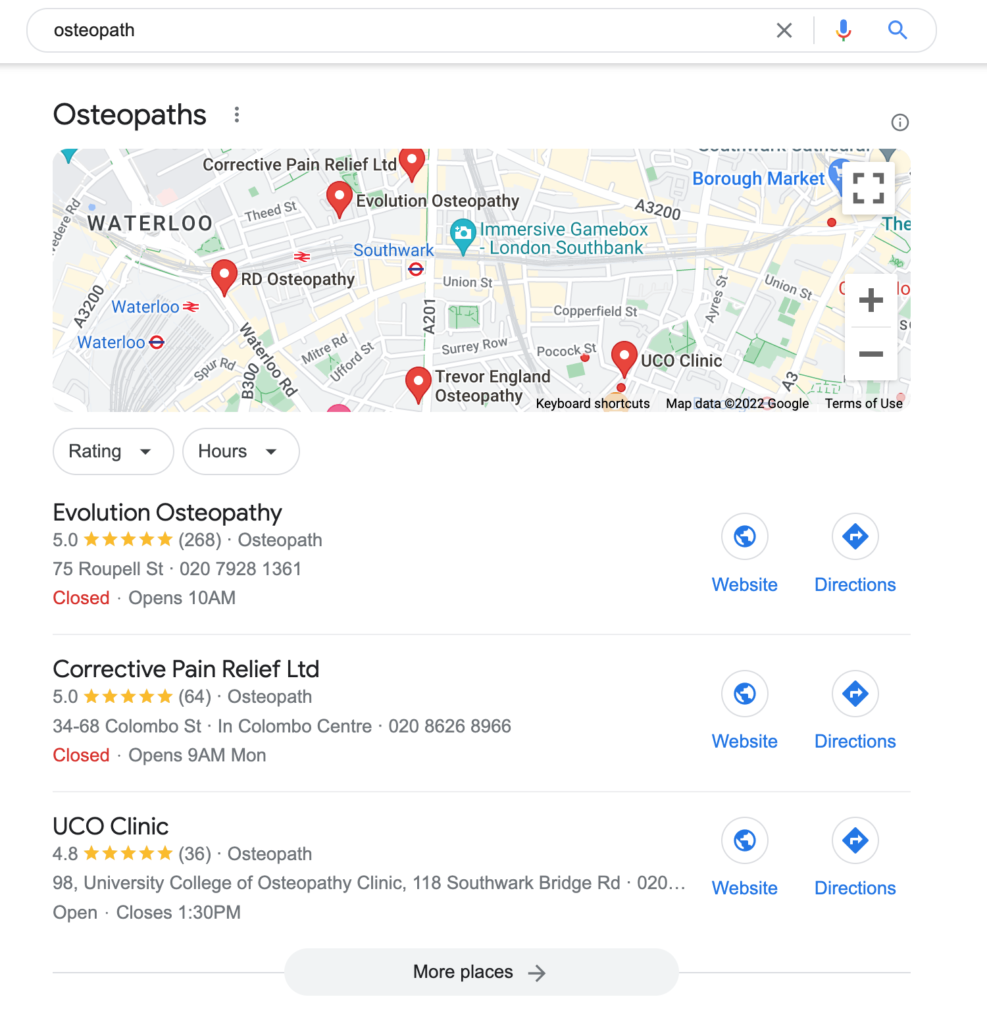
Depending on your search terms, Google might also return results in the main search which are also from your local area.
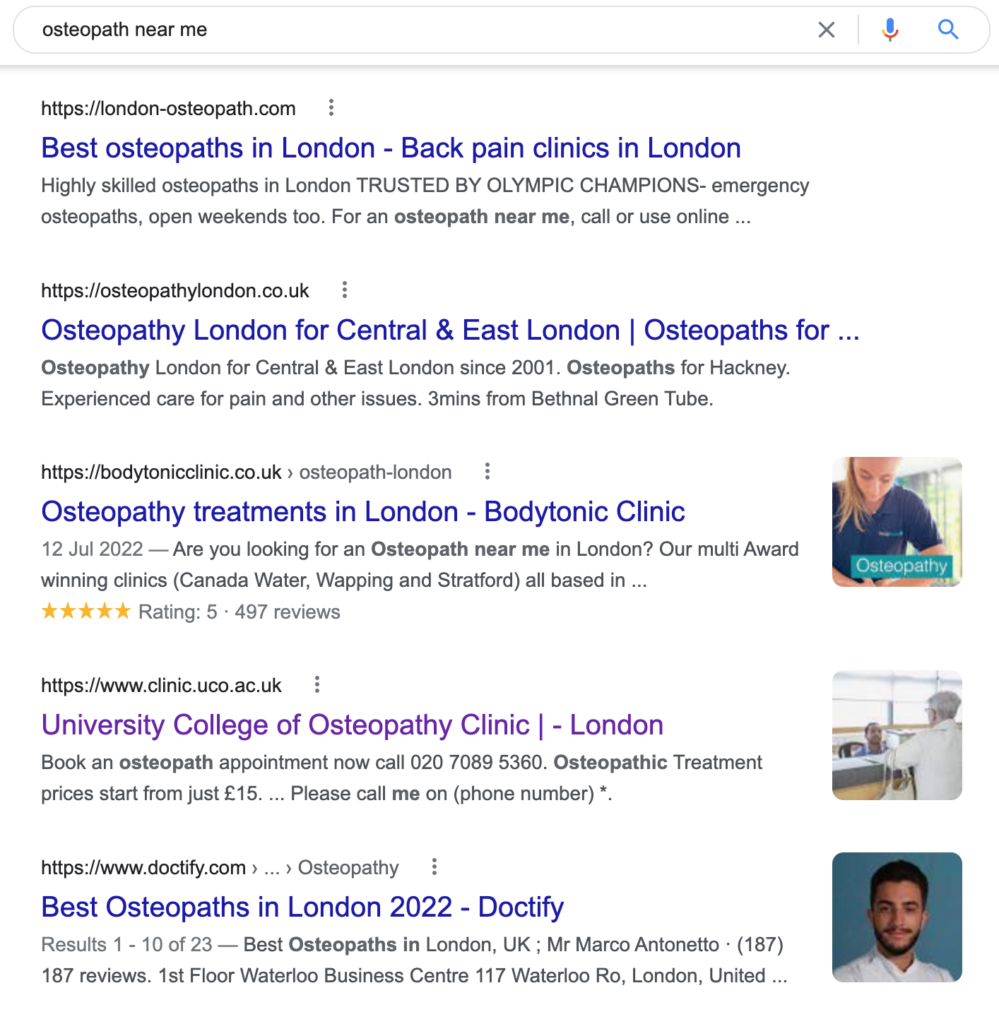
The average clinic will get all of its search traffic from local search, so this post is tailored to optimising for local searches.
Picking Your Optimisation Terms
Primary Optimisations
We’ll come to how to optimise in a minute, but before we do we need to know what terms we’re going to optimise for.
In all therapies, the most search traffic will come from people directly searching for three terms. They are:
- Business Name
- Service (e.g. physiotherapist, acupuncturist) – where your service has synonyms e.g. physio(therap(y/ist)), use them all
- Location (London, Bristol, etc.)
These will be our primary optimisations.
Secondary Optimisations
Secondary optimisations are variations on our service and location which we also want to target.
For example, if your primary service optimisation is physiotherapy, your secondary service optimisations might be sports injury, sports physiotherapy, private physiotherapy, pelvic floor physio, women’s physiotherapy and knee pain. The terms you choose will be determined by the services you offer and your market, and what people are searching for.
As for location variations, here in Waterloo my primary location optimisation might be either Waterloo or my postcode SE1, and my secondary location optimisations would be nearby areas I would also like to target, such as Southwark, Elephant and Castle and SE11, and more general areas such as Lambeth, Central London, South London and simply London.

Example List of Optimisations
So, if I am a physiotherapist in Waterloo, my optimisations might be:
Primary
Chris’s Physiotherapy Clinic
Physiotherapy
Waterloo
Secondary
Sports physiotherapy
Sports injury
Private physiotherapy
Knee pain
SE1
Southwark
Elephant and Castle
Lambeth
Central London
South London
Now that we have our terms to optimise for, let’s talk about how to optimise for them.
Getting on the Map – Optimising your Google Business Profile
Your Google Business Profile or GBP (formerly Google My Business) is a listing you create on Google which allows your business to appear on Google Maps (and therefore in local search maps like the one above) and for people to leave reviews on Google. You probably already have your GBP set up, if not you can do so here. If you have multiple clinics or practitioners, read this guide on structuring GBP for multiple clinicians or locations.
Our first task is to optimise our Google Business Profile. This is a higher priority than optimising our website because 1. it’s a vastly smaller job, and 2. it allows us to appear on the map at the top of search results, which is where most clicks are likely to happen.
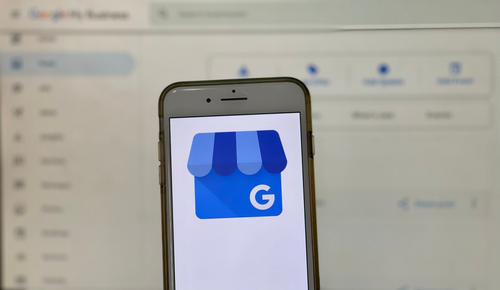
First and most importantly, make sure your business category is set to your main service, and additional categories to anything Google has that is relevant. You pick categories from a list, so you might have to pick categories that are more generic than you would like. For example I would like to add “SEO agency” and “Web Developer” to my categories shown below, but those options aren’t available.
Your Google Business Profile also allows you to add a 750-character description of your business. Write a description of your business, including all your main keywords. See mine below, I’ve got in there all my services (websites, SEO, etc) and the main markets I want to hit (physiotherapists, chiropractors, etc).
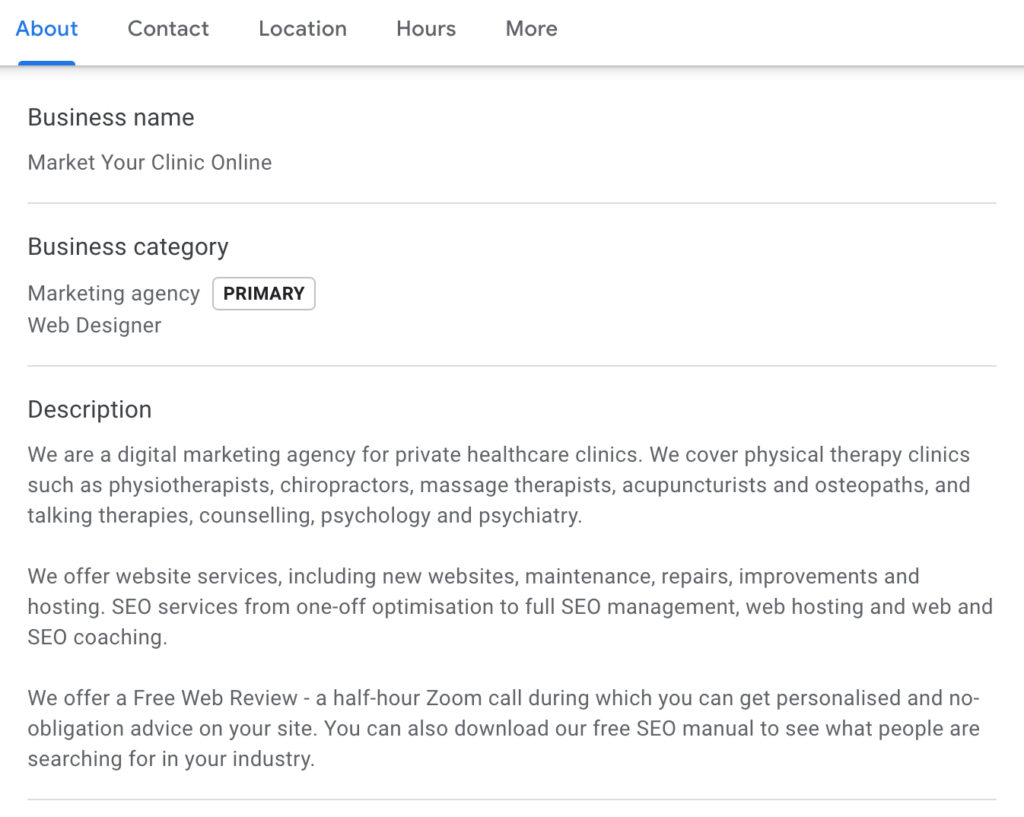
For my fictional physiotherapy clinic, the description might look something like this, which includes all the keywords I want to target:
Chris’s Physiotherapy Clinic is a private physiotherapy clinic in Waterloo, London SE1.
We offer private and sports physiotherapy treatment for conditions such as sports injuries and knee pain. We treat patients from all over Central and South London including Southwark, Lambeth, Elephant and Castle, SE1 and SE11.
We also offer Women’s Physiotherapy including pelvic floor physio.
Making an appointment is quick and easy using the online booking system on our website.
Lastly, you can add photos of your clinic to your Google Business Profile. Google likes photos and so do potential patients, so be sure to add photos of the inside and outside of your clinic, and of yourself and your staff. You can also rename your photos with your keywords before uploading them – so change 172484.JPG to physio-clinic-waterloo.jpg (personally I’m sceptical that this makes a difference but many SEO agencies think it does, and it sure can’t do any harm).
Google Business Profile Ranking Factors
So let’s say you google “physiotherapist” and there are 10 physiotherapists in the area. How does Google decide which ones will come first? This is determined by your authority, which is determined by your performance in various ranking factors.
Google don’t actually tell us what the ranking factors are, so we rely on experience and on sharing information between SEO professionals in the form of blogs, webinars, surveys and so on (see the Backlinko and Brightlocal reports on ranking factors). These factors change over time, and SEO professionals disagree on the relative importance of any individual factor. This is my personal top 6:
- Relevance to search (i.e. optimising your GBP for your keywords)
- How near you are to the person searching
- Amount and quality of reviews (100 5-star reviews will rank you much higher)
- Review optimisation (whether the search term appears in the reviews people have left)
- Relevance and quality of your website
- Behavioural factors (e.g. if the searcher stops searching after going to your website, Google assumes you satisfied their query and you are a better result for that search)
- NAP citations i.e. listings on business directories (I would have put this 2-3 steps higher a few years ago, but its relevance has declined)

Once your optimisations are done, the single biggest factor that you can improve on an ongoing basis is to build and curate positive reviews. Businesses with lots of positive reviews rank much higher than businesses without, so put in place a strategy to encourage your patients to leave them. There are some ideas in my post Google reviews not appearing? – What you can do.
Note – In late 2021 Google updated their algorithm with what is now called the vicinity update, making proximity to the searcher a much greater factor. The purpose of this is that the mom-and-pop business in the next street from you isn’t outranked by the large business 5 miles away, effectively making it more difficult to rank further away from your business. It also removed any advantage to having your service in your business name, so “Chris’s Physiotherapy” has no advantage over “Chris’s Healthy Bodies” in a search for ‘physiotherapy’.
Your Website
With your GBP optimised and your review-building strategy in place, it’s time to move on to your website.
Your website is important for conversion (i.e. turning someone who finds you online into a booking) because:
- The searcher looking for a coffee shop or chemist probably only cares which is nearest. The searcher looking for a healthcare service will almost definitely look at your website to find out what you’re all about before spending significant money on letting you manipulate their body or mind.
- You can allow patients to book directly from your site, saving admin time and creating a more streamlined patient experience.
And your website is important for SEO because:
- Your GBP will rank higher if you have a high-quality and relevant website
- A well-optimised site allows you to also rank in the listed search results below the map
- Websites with high authority (i.e. lots of inbound links) will rank higher in both map and listed results

How to Optimise Your Website
The first thing we did was to create a list of our primary and secondary optimisation terms, which we then put in our GBP. Optimising your website is basically the same thing – taking your optimisation terms and placing them in key places on your website so that Google knows what it’s about.
The difference is that there are many more “key” places on your website, and some may not be obvious if you’re not a web developer or SEO specialist. For any given web page, the most important parts of the page for SEO are:
- The URL (the address of the page, also called the slug)
- The <title> tag (also called SEO Title) – this appears in the browser tab
- The <meta> description (also called SEO Description) – this appears in the Google search results
- The <h1> tag (which should be the page heading) – which is normally but not necessarily the main heading on the page
- Number and quality of external links – relevant links to high authority websites like the NHS or WebMD will make a big difference
- Internal links to other pages on your site
- Image captions
- Image <alt> tags (which tell search engines what your images are of) – these are read by screen readers to visually impaired people
- <h2> – <h6> tags (subheadings)
- <p> tags or body copy (the main text of the page)
All of these things will will be editable from whatever website development platform you use e.g. WordPress, Squarespace, Wix, etc.
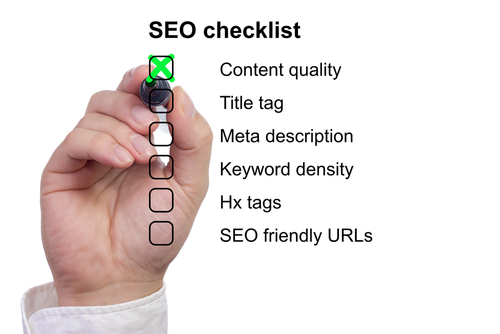
You will also have to consider the structure of your site – where you have multiple services, for example, are you going to create a page for each service or a page for all of them. Generally, creating pages for individual services, practitioners and clinics will have a greater SEO benefit than putting several things into one page, but you also have to consider whether you have enough to say to fill out a whole page, and how much time or budget you want to put into getting those pages created. If you want to optimise for the individual conditions you treat, see this guide to optimising for conditions or watch it in video form.
To ensure you hit local searches, put your clinic address(es) in the website footer in order that they are displayed on every single page. Make sure it matches exactly the address on your GBP and in any NAP citations you have.
For a healthcare website you also need to ensure your qualifications and experience are clearly displayed. Google reads your page with AI and tries to ensure that only advice from qualified professionals is displayed when the searcher is asking about healthcare or finance. Create a page for each practitioner at your clinic which lists clearly their qualifications and experience, and link to it from the other pages on your site. Where you have pages or blog posts which give advice on conditions, create an “about the author” or similar which mentions your qualifications and links to your page. This is part of what Google calls E-A-T, and you can read more about it in this post.

Of course your website is not just about SEO but about conversion. The job of your website is to take people who is interested in our services into someone who will contact us – it’s what we call a top-of-funnel tool. Too many people approach their website like a sales brochure that people will sit and read, when in reality it is more like an advert in a local paper, sitting alongside many other adverts for the same service. So cut out any irrelevant information and waffle, and ensure you include:
- The services you provide and where you are based
- Photos of clinicians, background and experience, so people know who they’re dealing with
- Social proof in the form of professional bodies and logos, and positive reviews from past clients
- Clear and easily-accessible information on practicalities like fees, booking, travel, etc.
- Regular call-to-actions i.e. ‘Click here to book an appointment now’

It goes without saying that good design – including a good mobile experience – is crucial. Nowadays we are accustomed to a pleasant and intuitive user experience, and anything which is unattractive or awkward will make potential patients spend less time on your site, and give an unprofessional image of your clinic.
Lastly it’s also important to consider Technical SEO. This refers to all the different ways that your website should be built, structured and coded from a technical point of view, and includes things like speed, mobile responsivity, including all the correct tags like <title> and <meta> tags, and experience for visually-impaired users. To find out more about your website’s technical SEO, book a Free Web Review which includes a free BrightLocal Technical SEO report on your site.
Improving Your Website Ranking – Link Building
In the GBP section we saw that when everything else is equal, the business with the most positive reviews will outrank the others. Reviews count as a kind of “vote” for your GBP.
The equivalent of a review “vote” for your website is an inbound link, i.e. when another website links to yours (and preferably when you don’t link back). Building links in to your site is a long-term strategy and generally centres around:
- Creating content worth linking to
- Asking people to link to it
For example, you may write a blog post on knee pain in runners and contact local running groups asking them to link to it from their website. Building links in this way is called content marketing. It’s not easy and you should be constantly on the lookout for opportunities to ask for links and to create content that will be useful for people.
You may find other ways to build links in to your site as well – for example by listing your website on directories that include a link to your website, offering discounts to local groups who will then link from their site, or by offering to write guest posts on other people’s sites including a link to your site (you can also Google search blogs in your field which accept guest posting).

Don’t be afraid to ask for a link or to make it a condition of any deal regarding content, discounts or so on. It’s common practice in digital marketing to ask for links and to build the inbound link into any agreement, including the “anchor text” that the link will have (i.e. the text you actually click on, which should ideally contain the keywords you want to target rather than saying something like “click here”).
Conclusion
There is always more SEO work you can do, and choosing your priorities is essential. If you are just starting out you may be happy with a well-optimised GBP and a 4-page website, especially if you want to use your budget for other things like buying clinic equipment. At the other end of the scale, clinics like Halsa employ full-time content creators to keep creating fresh content for SEO and link-building.
Below is a rough guide to prioritising your SEO work. How far down the list you choose to go is up to you, the size of your clinic and your goals, but this is a good order of importance:
- Create and optimise your GBP and curate reviews on an ongoing basis
- Create a simple, professional website that targets your SEO terms effectively and is optimised for conversion. A small, well-constructed and technically correct website is much better than one that is large, bloated and convoluted.
- Fill out your website content with pages for individual conditions you treat (see optimising for conditions).
- Start link building by using online directories and creating relationships with other local organisations, offering discounts and so on.
- Create a blog and content that will be useful / worth linking to. Link to it from your condition pages and other pages on your site, and start doing link outreach by asking people to link to it.
- Look at guest posting on other blogs, or writing articles for local websites, magazines, groups etc, which will give you an inbound link in return.

SEO and website services range from a simple website and one-off keyword research and optimisation, through to sites with a comprehensive knowledge base, and ongoing content creation and outreach. Understanding your priorities and what’s appropriate for your business stage and goals will help you choose the right services for your business and budget.
If you’d like to discuss what the next steps are for your website and SEO, and where you might be able to make simple improvements, book our Free Web Review. If you want to know more about our services you might also want to see our pricing page, or if you’re a physical therapist, download our Manual Therapy SEO Guide.
